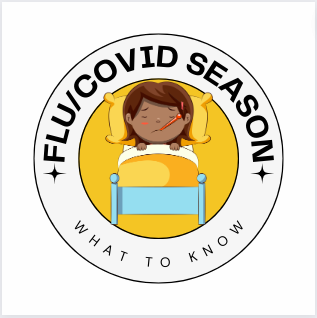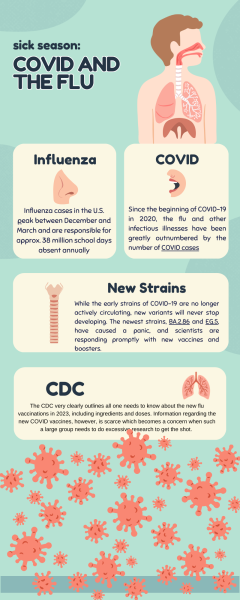
Flu and Covid season. Photo credit to: Canva
Dozens of PV students have stayed home with sickness in the past couple of weeks. Although cold and flu season typically doesn’t start until late November, this rapid turnover of immunity from summer is causing a ripple of issues.
The winter months bring on serious illness every year due to low immunity and cold, dry air. Previously named “flu season,” these months are now swamped with Coronavirus (COVID) cases. Is this COVID takeover necessary, or is the importance of flu prevention being immersed in all the chaos?
Influenza cases in the U.S. peak between December and March, and are responsible for approximately 38 million school days absent annually. The number of reported flu cases has decreased dramatically since 2020, yet sickness is just as prominent as ever. Widely available flu shots make the illness more manageable, but only to an extent.
The flu season is now being overlooked in the midst of new diseases.
Since the beginning of COVID-19 in 2020, the flu and other infectious illnesses have been greatly outnumbered by the number of COVID cases. The virus has been prioritized in recent years as a national emergency, and the 70% decrease in cold and flu cases from the year before COVID to 2022 exhibits this.

Many more people report positive cases of COVID than influenza because COVID is perceived to be more important in a public health stance, but this is not exactly true. Misnumbering flu cases and deaths can be misleading in terms of its severity, which has not changed since COVID began.
While the early strains of COVID-19 are no longer actively circulating, new variants will never stop developing. The newest strains, BA.2.86 and EG.5, have caused a panic, and scientists are responding promptly with new vaccines and boosters.
As new variants surface, the shots are becoming readily available and distributed to more clinics and drugstores nationwide.
Due to the rapidity of production, these shots cost more than an average flu shot, but this comes at a bigger cost when several boosters are recommended each year to fight against yet another variant.
The CDC very clearly outlines all one needs to know about the newest flu vaccinations in 2023, including ingredients and doses. Information regarding the new COVID vaccines, however, is scarce which becomes a concern when such a large group needs to do excessive research to get the shot.
This hasn’t deterred everyone, however. “My family and I decided to get the vaccine, specifically because my dad has bad asthma and we worried if he got it, it would not be easy for him to recover. I personally didn’t do much research but my family did and found they felt the vaccine was important for my family,” junior Aerielle Johnson remarked.”
It’s too soon to say what effect the new vaccine will have on the public, but past data poses a prediction.
The vaccines work by injecting COVID antigens into the body to imitate the illness. Like Johnson’s family implies, the vaccine is highly effective within some people’s immune system.
However, the vaccine has previously caused more damage than good in certain patients. “A few years ago my family all got the vaccines so we could safely travel to another country. I had no side effects and was perfectly fine to travel, but my sisters got so sick from the shot that we weren’t able to go on vacation at all,” stated freshman Kamran Foad.
The short time span between boosters can also pose an issue in the effectiveness of the vaccine. On paper, it is practical, but there are so many new strains being discovered that the turnover time from booster to booster is a concern. Just as new shots are released, a new variation of the disease comes out and a new antibody has to be created with minimal time for testing and production.
Staying informed is staying safe; with accurate and detailed information, COVID and the flu can be caught and managed this winter.
